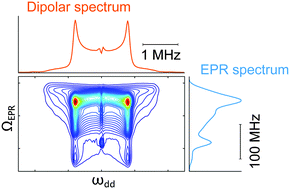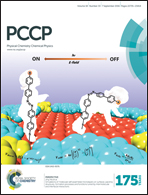EPR-correlated dipolar spectroscopy by Q-band chirp SIFTER†
Abstract
While two-dimensional correlation spectra contain more information as compared to one-dimensional spectra, typical spectral widths encountered in electron paramagnetic resonance (EPR) spectroscopy largely restrict the applicability of correlation techniques. In essence, the monochromatic excitation pulses established in pulsed EPR often cannot uniformly excite the entire spectrum. Here, this restriction is alleviated for nitroxide spin labels at Q-band microwave frequencies around 35 GHz. This is achieved by substitution of monochromatic pulses by frequency-swept chirp pulses tailored for uniform excitation. Unwanted interference effects brought by this substitution are analyzed for a pair of electron spins with secular dipolar coupling. Experimentally, the dipole–dipole interaction can be separated from other interactions by a constant-time Zeeman-compensated solid echo sequence called SIFTER. Such SIFTER experiments usually yield a one-dimensional dipolar spectrum. EPR-correlated dipolar spectra can be obtained when the four pulses are replaced by chirp pulses. These two-dimensional spectra encode additional information on the geometrical arrangement of the two spin labels. With the excitation parameters achieved by a home-built Q-band spectrometer capable of frequency-swept excitation, unwanted interference effects can be largely neglected for the examined model compound with a spin–spin distance of 4 nm. The experimentally obtained correlation pattern conforms to the expectation based on the inter-spin geometry of the investigated rigid model compound.


 Please wait while we load your content...
Please wait while we load your content...